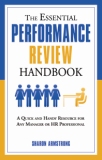At times, here at Positive Business DC, we like to review books that can help cultivate positive business. This one is by a local writer and consultant, Sharon Armstrong.
“It’s not supposed to be this way,” writes HR specialist Sharon Armstrong in the introduction to her new book, “The Essential Performance Review Handbook: A Quick and Handy Resource for Any Manager or HR Professional,” (www.theessentialperformancereviewhandbook.com).
Although performance reviews are actually less popular than a trip to the dentist for most supervisors (see that study below), the good news is that Sharon Armstrong — the woman who began her career in Human Resources in 1985 as a recruiter/trainer in a large Manhattan law firm and launched her own HR consulting business in the year 2000 — has found a way to take the pain out of the process.
Her new book offers 224 pages of advice on how to make the process productive, painless, and effective. The reason is simple. She’s been there.
“I know from firsthand experience that performance appraisals can be one of the most anxiety-provoking aspects of work life—for both supervisors and employees,” Armstrong says. “Appraisals are meant to clarify and reward, and to be interactive and fair. They take real time, real dialogue, and a real focus on the future, rather than just the previous few months. And they need to work successfully for all employees—not just the terrific ones.”
The reality: Why supervisors and employees fear performance reviews
Too often, Armstrong realizes, performance reviews don’t work.
“Supervisors often complain they are required to focus on tedious written forms, but don’t have enough training in how to use them,” she says. “They also worry about getting hit with complaints or lawsuits when there’s even a hint of discussion in the review about ‘improvement opportunities’. And there’s also the frustration of measuring intangibles.”
What’s more, employees often aren’t any happier about the performance review process.
“Anyone who is in the HR business knows that employees just plain dread appraisals, citing feelings of trepidation from one error that dragged on through 10 categories of the performance review, and frustration with perfunctory appraisals that neither acknowledge nor foster growth,” Armstrong adds. “As one employee told me, ‘The perception of the individual or relationship often dictates how critical or complimentary a supervisor can be.’ “
Why does one of the most vital workplace responsibilities show a shabby face?
Armstrong cites statistics and surveys to explain the problem:
•A 2006 survey by the Council of Communications Management (https://www.ccmconnection.com) confirmed what almost every employee knows—that positive feedback related to their efforts, and recognition for a job well done, are the top motivators of employee performance. Through formal evaluations and regular informal routes, performance appraisals yield excellent opportunities to motivate. Yet the process is frequently counterproductive, or viewed merely as perfunctory.
•According to the United Kingdom’s Institute of Personnel and Development (http://www.cipd.co.uk), one in eight managers would prefer to visit the dentist than carry out a performance appraisal. It’s not supposed to be this way. Rather than a painful yearly event, performance evaluation can be viewed as a culmination of small meetings, formal and informal, held throughout the evaluation period.
The good news: The Essential Performance Review Handbook offers help
“Happily,” Armstrong says, “the elements involved — goal setting, effective observation, practical documentation, and ongoing communications — can all be learned.”
Inside The Essential Performance Review Handbook you’ll find:
- Sound guidelines
- Sample evaluation forms
- Helpful insights for use on both sides of the desk
- Do’s and don’ts
- Tips for “owning” the appraisal
- Ways to leverage the review
The book is also peppered with quotes and ideas from top leaders. In Chapter 9, entitled, “Performance Reviews in a Changing World,” Armstrong quotes Microsoft Chairman Bill Gates who said, “What I do best is spread my enthusiasm.” Microsoft CEO Steve Ballmer added, “The end point must be exciting enough to stir thousands to uncommon effort.”
Useful sidebars also impart additional knowledge and information, including one in Chapter 7, “When Appraisals Derail,” which offers a blueprint for positive feedback. Armstrong advises:
- Give feedback that is specific and behavioral.
- Describe the behavior’s impact on the team or the attainment of the person’s goals.
- Express your observations calmly.
The future of Performance Reviews
In one form or another, performance reviews will continue to be a fact of our work life,” Armstrong believes. “This book is designed to cut through the anxiety and make the process more productive and less unpleasant.”
The book is also designed to bring performance appraisals into the 21st century, increase future-focused areas including: job sharing, telecommuting, shared supervision, team evaluations, legal concerns, and accommodating particular employee challenges.
“The chapters tap into the actual feelings of employees and their bosses,” Armstrong notes. “And you’ll find good examples and painful ones, real-life performance review problems — and guidelines on how to handle them.”
What do you think about performance reviews, dear reader? Love them? Hate them? We’d love to know…
About Sharon Armstrong
Sharon Armstrong began her career in human resources in 1985 as a recruiter/trainer in a large Manhattan law firm. Since launching her own consulting business in 2000, she has provided training and completed HR projects for hundreds of clients. Sharon is also the author of The Essential HR Handbook which she co-wrote in 2008 with fellow HR expert Barbara Mitchell.


